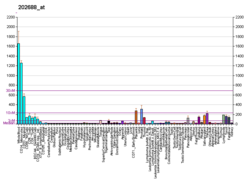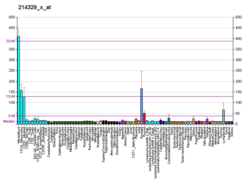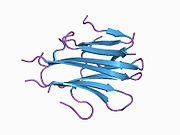TRAIL
In the field ofcell biology,TNF-related apoptosis-inducing ligand (TRAIL),is aproteinfunctioning as aligandthat induces the process of cell death calledapoptosis.[5][6]
TRAIL is acytokinethat is produced and secreted by most normal tissue cells. It causes apoptosis primarily intumorcells,[7]by binding to certaindeath receptors.TRAIL and its receptors have been used as the targets of several anti-cancer therapeutics since the mid-1990s, such asMapatumumab.However, as of 2013, these have not shown significant survival benefit.[8]TRAIL has also been implicated as a pathogenic or protective factor in various pulmonary diseases, particularlypulmonary arterial hypertension.[9]
TRAIL has also been designatedCD253(cluster of differentiation253) andTNFSF10(tumor necrosis factor(ligand) superfamily, member 10).[7]
Gene
[edit]In humans, the gene that encodes TRAIL is located atchromosome 3q26,which is not close to other TNF family members.[5]The genomic structure of the TRAIL gene spans approximately 20 kb and is composed of five exonic segments 222, 138, 42, 106, and 1245 nucleotides and four introns of approximately 8.2, 3.2, 2.3 and 2.3 kb.
The TRAIL gene lacksTATAandCAAT boxesand the promoter region contains putative response elements fortranscription factorsGATA,AP-1, C/EBP, SP-1,OCT-1,AP3, PEA3, CF-1, and ISRE.[citation needed]
The TRAIL gene as a drug target
[edit]TIC10(which causes expression of TRAIL) was investigated in mice with various tumour types.[8]
Small moleculeONC201causes expression of TRAIL which kills some cancer cells.[10]
Structure
[edit]TRAIL shows homology to other members of thetumor necrosis factorsuperfamily. It is composed of 281 amino acids and has characteristics of a type IItransmembrane protein.The N-terminal cytoplasmic domain is not conserved across family members, however, the C-terminal extracellular domain is conserved and can be proteolytically cleaved from the cell surface. TRAIL forms a homotrimer that binds three receptor molecules.
Function
[edit]TRAIL binds to thedeath receptorsDR4 (TRAIL-RI) and DR5 (TRAIL-RII). The process of apoptosis iscaspase-8-dependent. Caspase-8 activates downstream effector caspases including procaspase-3, -6, and -7, leading to activation of specific kinases.[11]TRAIL also binds the receptors DcR1 and DcR2, which do not contain a cytoplasmic domain (DcR1) or contain a truncated death domain (DcR2). DcR1 functions as a TRAIL-neutralizing decoy-receptor. The cytoplasmic domain of DcR2 is functional and activatesNFkappaB. In cells expressing DcR2, TRAIL binding therefore activatesNFkappaB,leading to transcription of genes known to antagonize the death signaling pathway and/or to promote inflammation. Application of engineered ligands that have variable affinity for different death (DR4 and DR5) and decoy receptors (DCR1 and DCR2) may allow selective targeting of cancer cells by controlling activation of Type 1/Type 2 pathways of cell death and single cell fluctuations. Luminescent iridium complex-peptide hybrids, which mimic TRAIL, have recently been synthesizedin vitro.These artificial TRAIL mimics bind to DR4/DR5 on cancer cells and induce cell death via both apoptosis and necrosis, which makes them a potential candidate for anticancer drug development.[12][13]
The TRAIL receptors as a drug target
[edit]In clinical trials only a small proportion of cancer patients responded to various drugs that targeted TRAIL death receptors. Many cancer cell lines develop resistance to TRAIL and limits the efficacy of TRAIL-based therapies.[14]
Interactions
[edit]TRAIL has been shown tointeractwithTNFRSF10B.[15][16][17]
See also
[edit]References
[edit]- ^abcGRCh38: Ensembl release 89: ENSG00000121858–Ensembl,May 2017
- ^abcGRCm38: Ensembl release 89: ENSMUSG00000039304–Ensembl,May 2017
- ^"Human PubMed Reference:".National Center for Biotechnology Information, U.S. National Library of Medicine.
- ^"Mouse PubMed Reference:".National Center for Biotechnology Information, U.S. National Library of Medicine.
- ^abWiley SR, Schooley K, Smolak PJ, Din WS, Huang CP, Nicholl JK,Sutherland GR,Smith TD, Rauch C, Smith CA (December 1995)."Identification and characterization of a new member of the TNF family that induces apoptosis".Immunity.3(6): 673–82.doi:10.1016/1074-7613(95)90057-8.PMID8777713.
- ^Pitti RM, Marsters SA, Ruppert S, Donahue CJ, Moore A, Ashkenazi A (May 1996)."Induction of apoptosis by Apo-2 ligand, a new member of the tumor necrosis factor cytokine family".The Journal of Biological Chemistry.271(22): 12687–90.doi:10.1074/jbc.271.22.12687.PMID8663110.
- ^ab"TNFSF10".NCBI Gene.
- ^abCormier Z (February 2013). "Small-molecule drug drives cancer cells to suicide".Nature.494.doi:10.1038/nature.2013.12385.S2CID76236123.
- ^Braithwaite AT, Marriott HM, Lawrie A (2018)."Divergent Roles for TRAIL in Lung Diseases".Frontiers in Medicine.5:212.doi:10.3389/fmed.2018.00212.PMC6072839.PMID30101145.
- ^ONC201: Stressing tumors to death. Feb 2016
- ^Song JJ, Lee YJ (May 2008)."Differential cleavage of Mst1 by caspase-7/-3 is responsible for TRAIL-induced activation of the MAPK superfamily".Cellular Signalling.20(5): 892–906.doi:10.1016/j.cellsig.2008.01.001.PMC2483832.PMID18276109.
- ^Masum AA, Yokoi K, Hisamatsu Y, Naito K, Shashni B, Aoki S (September 2018). "Design and synthesis of a luminescent iridium complex-peptide hybrid (IPH) that detects cancer cells and induces their apoptosis".Bioorganic & Medicinal Chemistry.26(17): 4804–4816.doi:10.1016/j.bmc.2018.08.016.PMID30177492.S2CID52149418.
- ^Masum AA, Hisamatsu Y, Yokoi K, Aoki S (2018-08-01)."Luminescent Iridium Complex-Peptide Hybrids (IPHs) for Therapeutics of Cancer: Design and Synthesis of IPHs for Detection of Cancer Cells and Induction of Their Necrosis-Type Cell Death".Bioinorganic Chemistry and Applications.2018:7578965.doi:10.1155/2018/7578965.PMC6092981.PMID30154833.
- ^Dimberg LY, Anderson CK, Camidge R, Behbakht K, Thorburn A, Ford HL (March 2013)."On the TRAIL to successful cancer therapy? Predicting and counteracting resistance against TRAIL-based therapeutics".Oncogene.32(11): 1341–50.doi:10.1038/onc.2012.164.PMC4502956.PMID22580613.
- ^Kaptein A, Jansen M, Dilaver G, Kitson J, Dash L, Wang E, Owen MJ, Bodmer JL, Tschopp J, Farrow SN (November 2000)."Studies on the interaction between TWEAK and the death receptor WSL-1/TRAMP (DR3)".FEBS Letters.485(2–3): 135–41.doi:10.1016/S0014-5793(00)02219-5.PMID11094155.S2CID38403545.
- ^Walczak H, Degli-Esposti MA, Johnson RS, Smolak PJ, Waugh JY, Boiani N, Timour MS, Gerhart MJ, Schooley KA, Smith CA, Goodwin RG, Rauch CT (September 1997)."TRAIL-R2: a novel apoptosis-mediating receptor for TRAIL".The EMBO Journal.16(17): 5386–97.doi:10.1093/emboj/16.17.5386.PMC1170170.PMID9311998.
- ^Hymowitz SG, Christinger HW, Fuh G, Ultsch M, O'Connell M, Kelley RF, Ashkenazi A, de Vos AM (October 1999)."Triggering cell death: the crystal structure of Apo2L/TRAIL in a complex with death receptor 5".Molecular Cell.4(4): 563–71.doi:10.1016/S1097-2765(00)80207-5.PMID10549288.
Further reading
[edit]- Almasan A, Ashkenazi A (2004). "Apo2L/TRAIL: apoptosis signaling, biology, and potential for cancer therapy".Cytokine & Growth Factor Reviews.14(3–4): 337–48.doi:10.1016/S1359-6101(03)00029-7.PMID12787570.
- Cha SS, Song YL, Oh BH (2004). "Specificity of molecular recognition learned from the crystal structures of TRAIL and the TRAIL:sDR5 complex".TRAIL (TNF-Related Apoptosis-Inducing Ligand).Vitamins & Hormones. Vol. 67. pp. 1–17.doi:10.1016/S0083-6729(04)67001-4.ISBN978-0-12-709867-8.PMID15110168.
- Song C, Jin B (2005). "TRAIL (CD253), a new member of the TNF superfamily".Journal of Biological Regulators and Homeostatic Agents.19(1–2): 73–7.PMID16178278.
- Bucur O, Ray S, Bucur MC, Almasan A (May 2006)."APO2 ligand/tumor necrosis factor-related apoptosis-inducing ligand in prostate cancer therapy".Frontiers in Bioscience.11:1549–68.doi:10.2741/1903.PMID16368536.
- Strandberg J, Louie AD, Lee S (June 2023). "TRAIL agonists rescue mice from radiation-induced lung injury".bioRxiv.doi:10.1101/2023.06.12.544681.S2CID259213466.
External links
[edit]- [1]Apoptosis, Trail & Caspase 8 -The Proteolysis Map-animation
- PDB:1D2Q
- TRAIL+Proteinat the U.S. National Library of MedicineMedical Subject Headings(MeSH)
- Overview of all the structural information available in thePDBforUniProt:P50591(Tumor necrosis factor ligand superfamily member 10) at thePDBe-KB.













